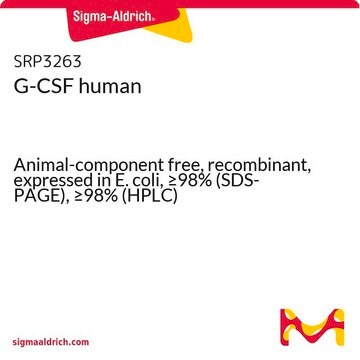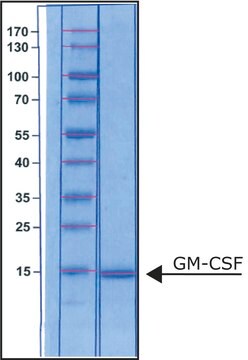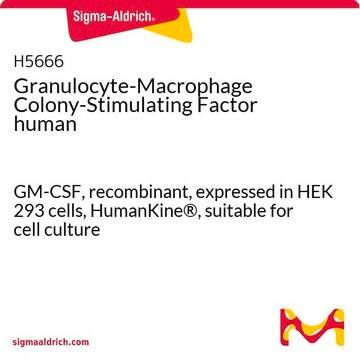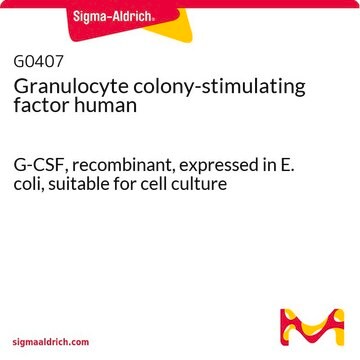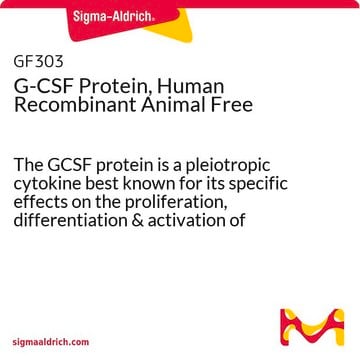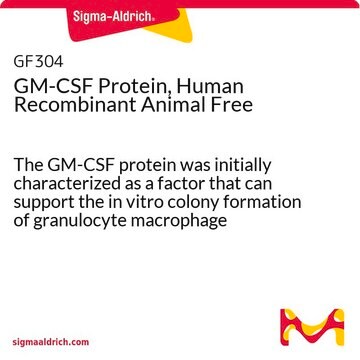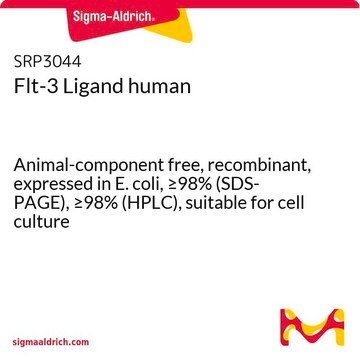G8160
Granulocyte Colony-Stimulating Factor from mouse
>97% (SDS-PAGE), recombinant, expressed in E. coli, lyophilized powder, suitable for cell culture
Synonym(s):
G-CSF
Sign Into View Organizational & Contract Pricing
Select a Size
All Photos(1)
Select a Size
Change View
About This Item
Recommended Products
Product Name
Granulocyte Colony-Stimulating Factor from mouse, G-CSF, recombinant, expressed in E. coli, suitable for cell culture
biological source
mouse
Quality Level
recombinant
expressed in E. coli
assay
>97% (SDS-PAGE)
form
lyophilized powder
potency
10-60 pg/mL ED50
quality
endotoxin tested
mol wt
19 kDa (179 amino acids including N-terminal methionine)
packaging
pkg of 5 and 25 μg
General description
The Csf3r (colony stimulating factor 3 receptor (granulocyte)) gene encodes a prototypical mobilizing cytokine.
Application
Granulocyte Colony-Stimulating Factor from mouse has been used in cytokine therapy.
Biochem/physiol Actions
G-CSF is a proliferation, differentiation, survival, and activation factor for hematopoietic cells of the restricted neutrophilic granulocyte lineage. It is produced by macrophages activated by endotoxin (LPS), by monocytes activated by TNF-α with IFNγ, by fibroblasts and endothelial cells activated by IL-1 or TNF-α, and by bone marrow stromal cells activated by IL-1 or LPS. It is suggested that during the inflammatory process endotoxins stimulate tissue macrophages to produce not only G-CSF but several other cytokines, including IL-1 and TNF-α, which in turn stimulate more G-CSF release from endothelial cells and fibroblasts. G-CSF can also synergize with IL-3 to shorten the G0 period of early hematopoietic progenitors. In addition to the namesake proliferative activity, G-CSF acts on mature neutrophils to enhance their survival and to stimulate their tumorcidal activity. Human G-CSF binds and activates a 130 kD to150 kD glycoprotein single chain receptor that has been classified as a member of the hematopoietic (cytokine) receptor family, the cytokine receptor class I, or the gp130 related cytokine receptor family (although it does not apparently bind to gp130). G-CSF receptors can be found on neutrophils, myeloid leukemia cells that respond to G-CSF, bone marrow cells of neutrophilic granulocyte lineage, and on placental trophoblasts, plus a soluble form may be expressed. Two forms of human G-CSF (177 and 174 amino acids) are synthesized from a single gene by alternative splicing, but murine G-CSF is a single expressed form of 178 amino acids. Human and murine G-CSF share 73% amino acid sequence homology and full cross-reactivity.
Granulocyte colony-stimulating factor (G-CSF) is a lineage-restricted hematopoietic growth factor, stimulating final mitotic divisions and the terminal cellular maturation of the partially differentiated hematopoietic progenitors. G-CSF3,4 is produced by monocytes and fibroblasts. It stimulates granulocyte colony formation, activates neutrophils and mature granulocytes, and promotes differentiation of certain myeloid leukemic cells. Natural G-CSF is a glycoprotein of 177 amino acids and a molecular weight of 19 kDa.5 Human and murine G-CSF have about 75% homology and show biological cross-reactivity.
Physical form
Lyophilized from a 0.2 μm filtered solution in 10 mM citric acid, 0.01% TWEEN® 20, pH 4.0, containing 50 μg bovine serum albumin per 1 μg of cytokine.
Analysis Note
The biological activity is measured in a cell proliferation assay using a murine myeloblastic cell line, NFS-60.
Legal Information
TWEEN is a registered trademark of Croda International PLC
related product
Product No.
Description
Pricing
signalword
Warning
hcodes
Hazard Classifications
Eye Irrit. 2 - STOT SE 3
target_organs
Respiratory system
Storage Class
11 - Combustible Solids
wgk_germany
WGK 3
flash_point_f
Not applicable
flash_point_c
Not applicable
ppe
Eyeshields, Gloves, type N95 (US)
Choose from one of the most recent versions:
Already Own This Product?
Find documentation for the products that you have recently purchased in the Document Library.
Combining pharmacological mobilization with intramyocardial delivery of bone marrow cells over-expressing VEGF is more effective for cardiac repair
Wang Y, et al.
Journal of Molecular and Cellular Cardiology, 40(5), 736-745 (2006)
Hitesh S Deshmukh et al.
Nature medicine, 20(5), 524-530 (2014-04-22)
Neonatal colonization by microbes, which begins immediately after birth, is influenced by gestational age and the mother's microbiota and is modified by exposure to antibiotics. In neonates, prolonged duration of antibiotic therapy is associated with increased risk of late-onset sepsis
Expression of the G-CSF receptor in monocytic cells is sufficient to mediate hematopoietic progenitor mobilization by G-CSF in mice
Christopher MJ, et al.
The Journal of Experimental Medicine (2011)
Expression of the G-CSF receptor in monocytic cells is sufficient to mediate hematopoietic progenitor mobilization by G-CSF in mice
ChristopherMJ, et al.
The Journal of Experimental Medicine (2011)
S Shyam et al.
Theriogenology, 157, 254-262 (2020-08-22)
A functional canonical WNT signaling pathway exists in preimplantation embryos and inhibits embryonic development. Recent studies suggest that this pathway is over-expressed in nuclear transferred (NT), compared to IVF embryos. The present study investigated the effects of Dickkopf-1 (DKK1), an
Our team of scientists has experience in all areas of research including Life Science, Material Science, Chemical Synthesis, Chromatography, Analytical and many others.
Contact Technical Service